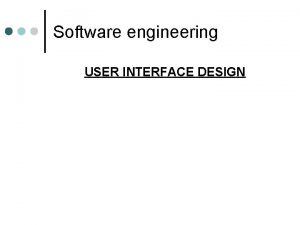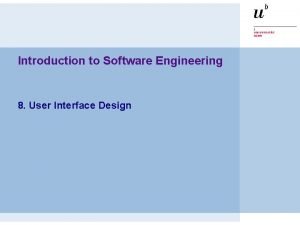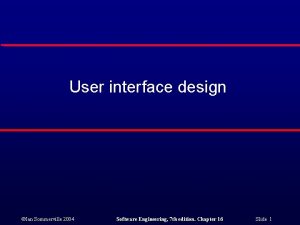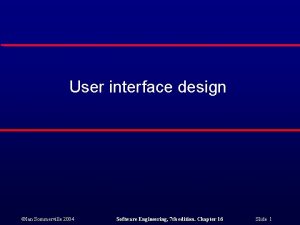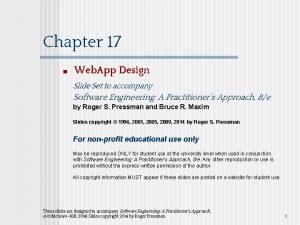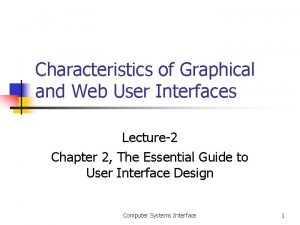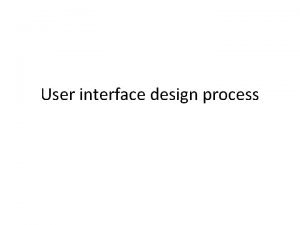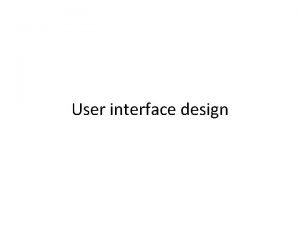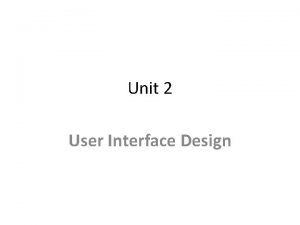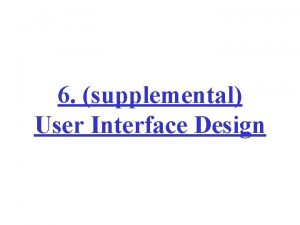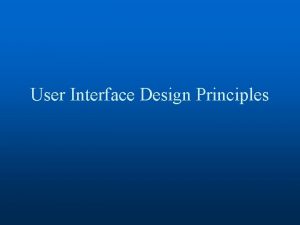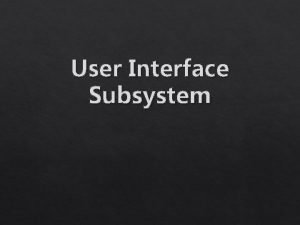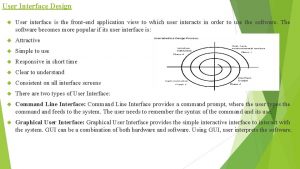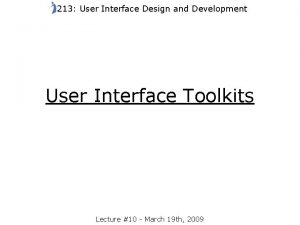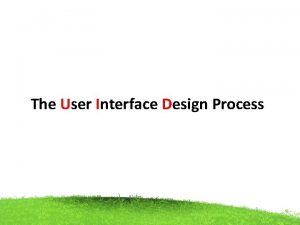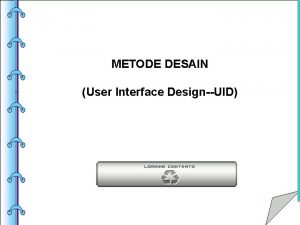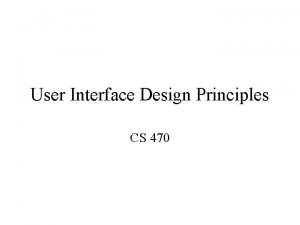Software engineering USER INTERFACE DESIGN Characteristics of a














- Slides: 14

Software engineering USER INTERFACE DESIGN

Characteristics of a user interface ¢ Speed of learning. A good user interface should be easy to learn. Speed of learning is hampered by complex syntax and semantics of the command issue procedures. A good user interface should not require its users to memorize commands.

Speed of use of a user interface is determined by the time and user effort necessary to initiate and execute different commands. ¢ Speed of recall. Once users learn how to use an interface, the speed with which they can recall the command issue procedure should be maximized. ¢

¢ Error prevention. A good user interface should minimize the scope of committing errors while initiating different commands. ¢ Attractiveness. A good user interface should be attractive to use. In this respect, graphics-based user interfaces have a definite advantage over text-based interfaces. Consistency. The commands supported by a user interface should be consistent. Consistency facilitates speed of learning, speed of recall, and also helps in reduction of error rate. Feedback. A good user interface must provide feedback to various user actions. ¢ ¢

¢ ¢ Error recovery (undo facility). While issuing commands, even the expert users can commit errors. Therefore, a good user interface should allow a user to undo a mistake committed by him while using the interface. User guidance and on-line help. Users seek guidance and on-line help when they either forget a command or are unaware of some features of the software. Whenever users need guidance or seek help from the system, they should be provided with the appropriate guidance and help.

BASIC CONCEPTS: Mode-based interface vs. modeless interface ¢ ¢ ¢ A mode is a state or collection of states in which only a subset of all user interaction tasks can be performed. In a modeless interface, the same set of commands can be invoked at any time during the running of the software. Thus, a modeless interface has only a single mode and all the commands are available all the time during the operation of the software. On the other hand, in a mode-based interface, different set of commands can be invoked depending on the mode in which the system is.

Graphical User Interface vs. Text-based User Interface l l In a GUI multiple windows with different information can simultaneously be displayed on the user screen. This is perhaps one of the biggest advantages of GUI over textbased interfaces. Iconic information representation and symbolic information manipulation is possible in a GUI.

A GUI usually supports command selection using an attractive and userfriendly menu selection system. ¢ In a GUI, a pointing device such as a mouse or a light pen can be used for issuing commands. The use of a pointing device increases the efficacy issue procedure. ¢

Some advantages about TBUI On the other hand, a text-based user interface can be implemented even on a cheap alphanumeric display terminal. ¢ Graphics terminals are usually much more expensive than alphanumeric terminals. ¢

Types of user interfaces ¢ User interfaces can be classified into the following three categories: • Command language based interfaces l • Menu-based interfaces l • Direct manipulation interfaces l

Command Language-based Interface ¢ ¢ A command language-based interface – as the name itself suggests, is based on designing a command language which the user can use to issue the commands. The user is expected to frame the appropriate commands in the language and type them in appropriately whenever required. A command language-based interface can be made concise requiring minimal typing by the user. Command language-based interfaces allow fast interaction with the computer and simplify the input of complex commands.

Menu-based Interface ¢ ¢ ¢ An important advantage of a menu-based interface over a command language-based interface is that a menu-based interface does not require the users to remember the exact syntax of the commands. A menu-based interface is based on recognition of the command names, rather than recollection. Further, in a menu-based interface the typing effort is minimal as most interactions are carried out through menu selections using a pointing device.

Direct Manipulation Interfaces ¢ ¢ Direct manipulation interfaces present the interface to the user in the form of visual models (i. e. icons or objects). For this reason, direct manipulation interfaces are sometimes called as iconic interface. In this type of interface, the user issues commands by performing actions on the visual representations of the objects, e. g. pull an icon representing a file into an icon representing a trash box, for deleting the file. Important advantages of iconic interfaces include the fact that the icons can be recognized by the users very easily, and that icons are language-independent.

Thank U…
 User interface in software engineering
User interface in software engineering Types of user interface in software engineering
Types of user interface in software engineering User interface design in software engineering
User interface design in software engineering User interface design steps in software engineering
User interface design steps in software engineering User interface design in software engineering
User interface design in software engineering User interface design process in software engineering
User interface design process in software engineering User interface prototyping in software engineering
User interface prototyping in software engineering User interface design in system analysis and design
User interface design in system analysis and design What are the inputs and outputs of system design?
What are the inputs and outputs of system design? Design pyramid for webapps
Design pyramid for webapps Web user interface
Web user interface Characteristics of graphical user interface in hci
Characteristics of graphical user interface in hci Characteristics of graphical user interface
Characteristics of graphical user interface Principle of input design
Principle of input design User interface design cycle
User interface design cycle

